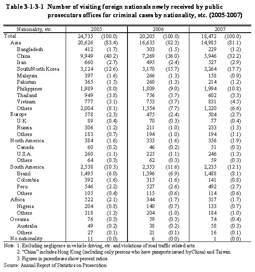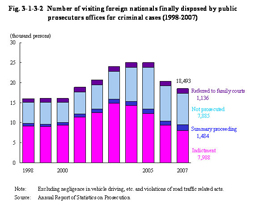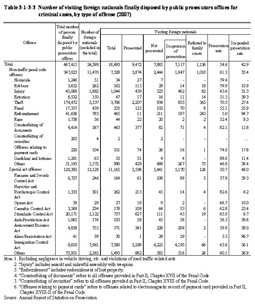| Previous Next Index Image Index Year Selection | |
|
|
1 Disposition by public prosecutors offices Table 3-1-3-1 shows the number of visiting foreign nationals newly received by public prosecutors offices for criminal cases (excluding negligence in vehicle driving, etc. and violations of road traffic related acts) by nationality, over the last three years. Table 3-1-3-1 Number of visiting foreign nationals newly received by public prosecutors offices for criminal cases by nationality, etc. (2005–2007) For each year, persons with nationality, etc. of the Asian regions accounted for more than 80%. In 2007, the number was largest for those from China, followed by those from South/North Korea, the Philippines, Brazil, Vietnam, and Thailand.(2) Visiting foreign nationals disposed by public prosecutors offices for criminal cases Fig. 3-1-3-2 shows the number of visiting foreign nationals finally disposed by public prosecutors offices for criminal cases (excluding negligence in vehicle driving, etc. and violations of road traffic related acts; hereinafter the same in this section) over the last 10 years (see Appendix 3-3). The number of visiting foreign nationals finally disposed by public prosecutors offices for criminal cases was on a rising trend from 1998 to 2004, but decreased slightly in 2005, and further decreased by 1,783 (8.8%) from the previous year in 2007. Fig. 3-1-3-2 Number of visiting foreign nationals finally disposed by public prosecutors offices for criminal cases (1998–2007) Table 3-1-3-3 shows the number of visiting foreign nationals finally disposed by public prosecutors offices, by type of offense, for criminal cases in 2007.The number of visiting foreign nationals who were finally disposed for criminal cases accounted for 4.0% of the total number of disposed persons (467,415 persons) (excluding negligence in vehicle driving, etc. and violations of road traffic related acts; hereinafter the same in this section) and 75.2% of the total foreign nationals finally disposed (24,598 persons) (excluding negligence in vehicle driving, etc. and violations of road traffic related acts; hereinafter the same in this section). By type of offense, of non-traffic penal code offenses, theft had the largest share, followed by injury (including assault and unlawful assembly with weapons), embezzlement (including embezzlement of lost property), and counterfeiting of documents (including all the offenses stipulated in Part II, Chapter XVII of the Penal Code). Of special act offenses, Immigration Control Act violations had the largest share, followed by Stimulants Control Act violations, Amusement Business Act violations, Narcotics and Psychotropic Control Act violations, and Cannabis Control Act violations. The prosecution rate of criminal cases committed by visiting foreign nationals in 2007 was 17.7 points higher (at 61.3%) than that of the total disposed persons (43.6%) for non-traffic penal code offenses, and was 9.5 points lower (at 50.7%) than that of the total disposed persons (60.2%) for special act offenses. Table 3-1-3-3 Number of visiting foreign nationals finally disposed by public prosecutors offices for criminal cases, by type of offense (2007) |


